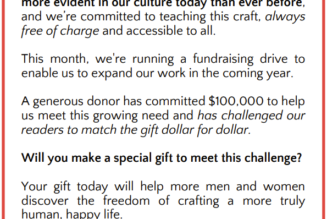
Popular women’s fashion brand Doen recently took to Instagram to broadcast its financial and moral support for Planned Parenthood. For Giving Tuesday, the company’s Instagram feed featured a black and white photo of the two attractive foundresses holding a banner that read, “Women’s Rights Are Human Rights.”
That a women’s clothing brand might be politically progressive is hardly surprising. Unexpected was the volume of well-reasoned and unapologetic backlash the company received in the comments from its followers, who were mostly young mothers.
The clothing brand, started by two Santa Barbara sisters in 2015, is the picture of ethereal California cool. Gauzy floral dresses adorn bohemian-styled models with unkempt hair. The look is decidedly feminine but with an unruly edge and aspirational price points.
Advertising executives know that what they’re doing is more fundamentally enmeshed in our psychology than in our pocketbooks.
While the brand might pride itself on being on the cutting edge in its representation of womanhood, Doen seems suddenly and woefully out of step with the times in a far deeper way.
Women have been propagandized by lifestyle terrorism for decades. Like so much of the emerging institutional distrust, they are beginning to see through the narratives so long thrust upon them. The messages to be a fierce woman, a nasty woman, are stale descendants of “I Am Woman Hear Me Roar.” This is all your grandma’s propaganda, and it rings as hollow as barren Boomer wombs.
The Doen Instagram post captured the currently favored fashionable image of womanhood as feminine and fierce. But a woman-centered company uniting with the abortion industry might more accurately be described as a fraud. There really is nothing feminine about abortion, for there is nothing more distinctively womanly than the capacity to bear children. It is truly the pre-eminent thing women can do that men cannot.
Planned Parenthood certainly does, however, have the “fierce” part down. The company serves as the final solution for the millions of children each year who must be disposed of to perpetuate the lie of meaningless sex and the untethered woman. Fierce indeed.
Fashion seems like a harmless diversion, and that impression allowed it to have a sort of choke hold on so many of us. We followed its lead and let it form our longings — longings about far more than a new dress or the latest rise in jeans. We were being formed into who we wanted to be. Maybe that sounds ridiculous, but speak to any advertising executive. They know that what they’re doing is more fundamentally enmeshed in our psychology than in our pocketbooks.
Beyond forming our longings, it also informed our aversions. The worst thing you can be in fashion or in a cultural revolution is outdated, and so the two have worked well in tandem. The sexual revolution faced the impossible task of convincing women that it is not just old fashion trends that should be cast off but human beings and human nature itself. It is a definition by negation, a vision of who we should be grounded in a denial of who we are.
This unmaking of the human person affected not just women but every member of the human family: Men became soft, women hardened, children unprotected.
Social re-engineering requires escalating forms of manipulation. Like fashion, the revolution initially just had to be sold as attractive. Next, it had to capitalize on the fear of being out of step and the need to belong by convincing women that everyone was embracing this new look and life.
Once normalized, the manipulation turns to exploitation of the harm wrought by the revolution itself. The damage to women has been grave and great. The numerous social pathologies that flow from it have the potential to expose the lie at its heart and prompt a correction as women rightfully seek the source of their woundedness. But turning wounds into rage is every revolution’s currency, and that currency is only and always reinvested in a zealous recommitment to its tenets.
The demolition of any solid conception of what a woman is and how she should live has left many grasping at peripherals like fashion to determine our core. But the lies are exposed in little tidal waves, even in something as seemingly insignificant as the backlash against a fashion photo of two cool but clueless women holding the sign, “Women’s Rights Are Human Rights.”
You don’t get to claim to believe in human rights if you think there are some humans who do not have them. The gauzy dress is too transparent; the outdated sloganeering has no life. Both are easily cast off in favor of the timelessness of simply saying true things that need no force of manipulation to make them attractive.







